The landslips that have blocked the A83 through the Rest and Be Thankful more or less continuously since August are a wonderful example of what happens when decision-making is not informed by an understanding of the natural environment and fails to consider the consequences. From the original decision to route the A83 across the unstable glacial debris and poor soils on the southern face of Beinn Luibhean, to the disregard of the impact that grazing animals had on its stability and the pitiful attempts to hold it back through pits and wire netting, mistake after mistake has been made. We need more than spin and wishful thinking:
“As part of the £82 million invested in the maintenance of the A83 since 2007, over £13.6 million has been invested in landslide mitigation works at the Rest and Be Thankful. This was to help keep Argyll open for business by reducing the impact of landslides on the A83”.
Really?
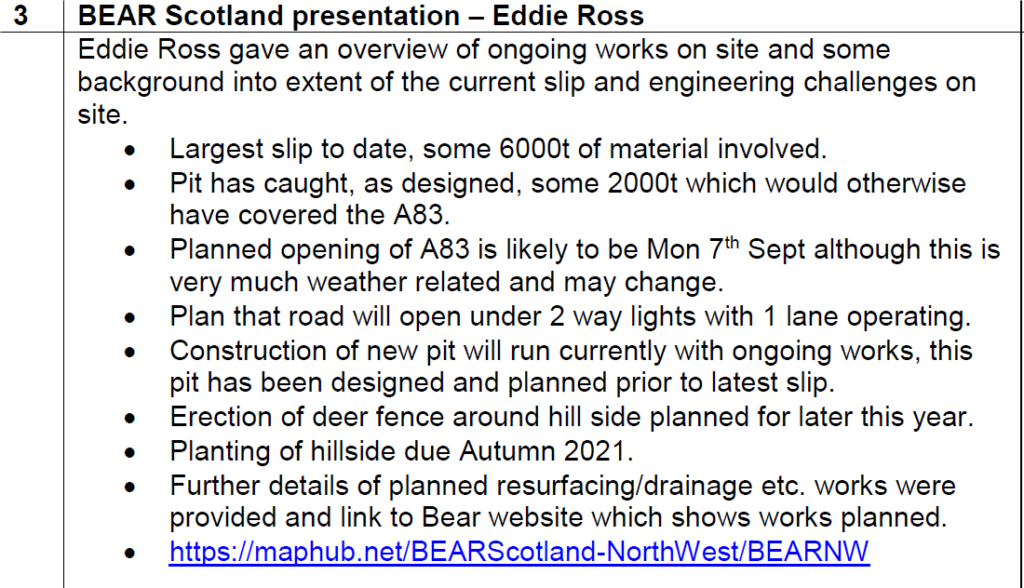
Despite spending £13.6m on protective measures up to August, the pits weren’t nearly large enough and the plan to re-open the A83 soon failed. The danger the slope poses has subsequently been acknowledged by decision to build a 175m long protective bund to protect the old military road, which had been upgraded to serve as a relief road in case the A83 got blocked. Transport Scotland’s recent consultation is a further acknowledgement that the Scottish Government now accepts that an alternative route or plan is required needed.
This post takes a look at the proposed route solutions before considering in more detail the plans to use “natural” solutions to stabilise the slope.
Re-routing the A83
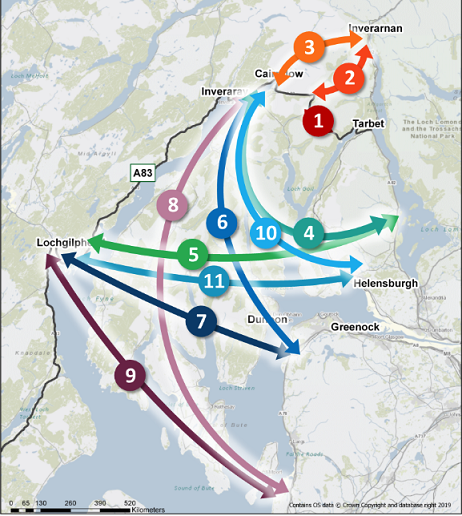
Transport Scotland’s consultation between 23 September and 30 October 2020 offered no less than eleven different options for connecting Argyll to the Clyde conurbation. Most were about as realistic as Boris Johnson’s proposals to build a bridge over to Northern Ireland. No costs were given for the various options but, from the descriptions, most are not feasible, whether because of the threat of landslips (options 2 and 3) or the engineering challenges of building bridges across Loch Fyne and the Clyde Estuary (options 4 to 9). Added to which the UK Government would veto any option which might impact on nuclear submarines. There were 650 responses, still to be published, but it is likely most will argue that the Scottish Government needs to find a safe route along the existing line taken by the A83.
Transport Scotland is now considering alternatives for Glen Croe, including re-routing the road along the opposite side of the glen, which it states it will report on by Spring 2021.
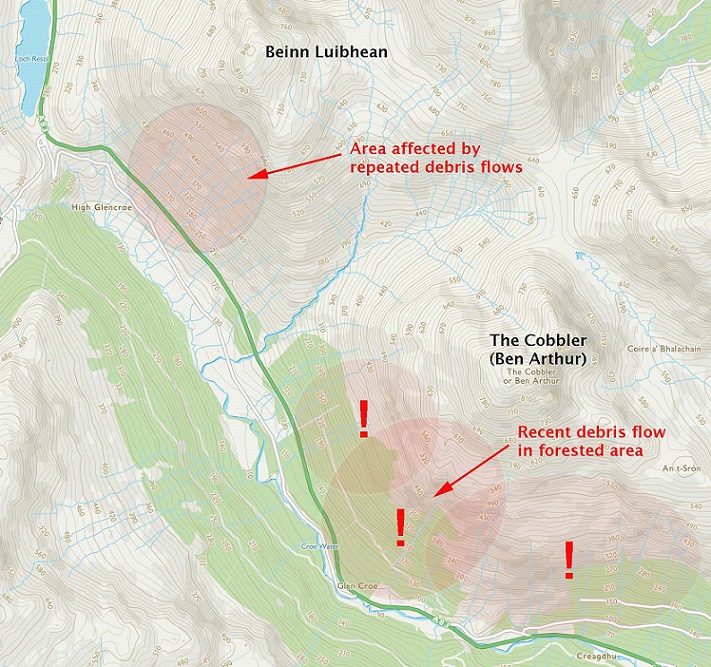
In their response to the consultation, which they issued as a news release (see here), the Friends of Loch Lomond and Trossachs helpfully pointed out that Beinn Luibhean is not the only place where landslips occur in Glen Croe and suggested alpine style avalanche shelters as a solution. Unless these were cut into the hillside as a half-tunnel, they would have significant landscape impacts and there would be questions about how strong they would need to be to withstand the 100,000s of tonnes of debris remaining on Beinn Luibhean.
My own view is that these issues make the case for a tunnel even more compelling. It is what would happen in Norway, whose mountains are part of the same Caledonian Mountain chain that formed the hills in Arrochar, and would have happened 100 years ago when Scotland led the world in tunneling capacity . The problem is all the failed solutions at the Rest and Be Thankful to date have been driven by cost rather than by an understanding of what it would be best to do given the natural environment locally.
Tree planting – why the delays?
Transport Scotland’s announcement about the 175m protective bund (see here), included the news that Forestry and Land Scotland (FLS) were starting to erect a deer fence around the landslip area with a view to planting native broadleaves on the slopes in Autumn 2021. There are now comprehensive plans for the Rest and Be Thankful woodland creation project. These are a credit to FLS and the staff involved but they do raise serious questions about how long it has taken to get this far, not least because the latest plan is already a year behind schedule:

The history for this goes back 16 years. Following a number of serious landslips in August 2004, including at the Rest and Be Thankful, Transport Scotland carried out the Scottish Road Network Landslides Study. This identified the A83 from Ardgartan to the Rest and Be Thankful as one of the most highly ranked debris flow hazard sites in Scotland. The 2004 report, however, said little about the role that trees could play in mitigating slope instability, despite significant research being available at the time.
After the landslip events of 2012 Forest Research produced an excellent report on the potential for woodland restoration above the A83 (see here). This is recommended reading for anyone who wants to understand the impact of grazing on slope stability and the role that trees can play in countering this. The report was endorsed by a further report from Transport Scotland later in the year. Its taken a mere eight years since then to start putting up a fence.
Part of the explanation for the delay may lie in the time it has taken for FLS to negotiate with the farmer who, in 2012, was using the land to graze sheep and cattle:
“The current owner of the land currently runs ~200 head of sheep on the hill ground above the road, with a further 40 – 50 head of cattle (beef suckler) being put onto the hill during the summer months, to reduce the spread of course grasses and bracken. There is an unknown transient deer population, which is largely hefted within the surrounding forest blocks; they too have a significant influence upon the hill. The future management of the site will depend on the intentions of the owner, and this report is intended to aid discussions about the possibilities for improving site stability.”
While the local Councillor, Shonny Paterson, who is now on the Loch Lomond and Trossachs National Park Authority, claimed at their December Board meeting to “know as a fact” that the farmer had not had sheep on land for years, sheep were actually grazing the slopes as recently as last year:
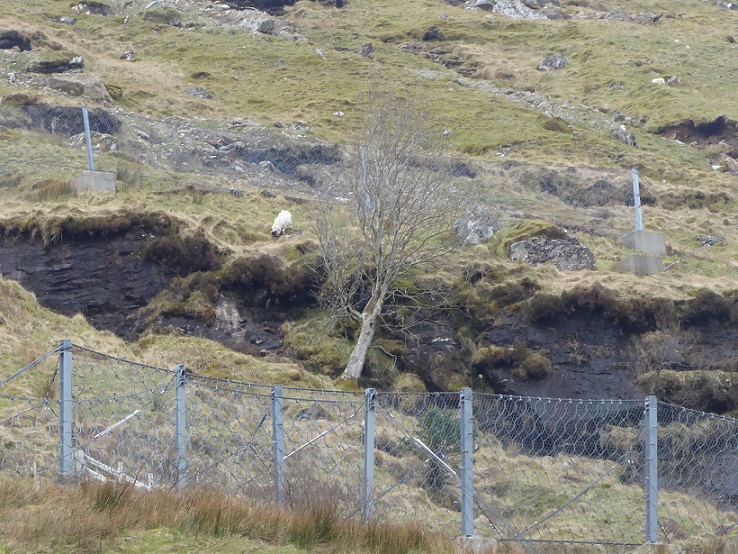
The 2012 report described the problem:
“There were also a few tree seedlings seen, Downy Birch (Betula pubescens) and some Rowan (Sorbus aucuparia). These had been heavily grazed and only the occasional Rowan was seen growing from a rock fissure, or other inaccessible site, where it had avoided being browsed or burnt. There were some small, Eared willow (Salix aurita) seedlings adjacent to the roadside, but these have been readily grazed out elsewhere across the site.”
It is possible, however, the sheep that I saw in 2019 were “feral & marauding sheep”, described by the FLS as “a management issue that requires constant attention”.
Whatever date the farmer officially decided to stop using the land for grazing, it appears that eventually FLS was forced to buy out the entire 760 hectares of the upper Glen Croe farm, including the summit of Ben Ime and land to the east, in order to enable woodland restoration to happen.
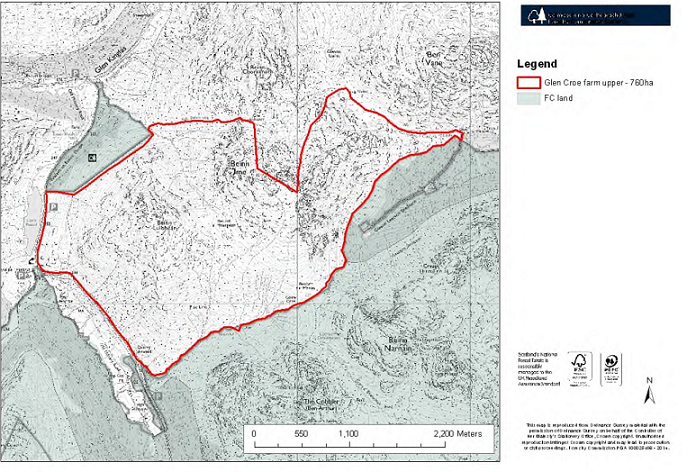
The purchase again appears to have taken an inordinate length of time. While the land is now in public ownership, the date of sale and the price has not yet been logged on the Registers of Scotland. In retrospect, rather than FLS negotiating with the farmer, it might have been a lot quicker if Transport Scotland had used its powers to compulsorily purchase the land to protect the A83. But that would have meant challenging the powers of landowners to manage their land as they wish and the Scottish Government is reluctant to do this when when it would clearly be in the public interest.
While all of this has been going on, the Scottish Government has effectively lost 8 years in which trees could have started to stabilise the slope, whether through natural regeneration from the pockets of trees by the road or planting. They should not repeat the same mistakes elsewhere. The Scottish Government and Transport Scotland would be well advised now to go back to the 2004 study, review it in the light of the latest data on extreme rain events, and identify places where woodland regeneration might help to stabilise slopes and then draw up plans to make this happen.
In the brief and unscheduled discussion on the landslips in the Rest and Be Thankful at the December LLTNPA meeting, where Cllr Paterson made his remark, Professor Chris Spray effectively made this point when he suggested the slopes above the A84 in Glen Ogle should be another priority area for woodland regeneration within the National Park. The truth is that with more frequent and extreme rain events, there are now dozens of slopes at serious risk and neither the LLTNPA nor the Scottish Government has a plan worthy of the name.
Tree planting – why deer fencing?
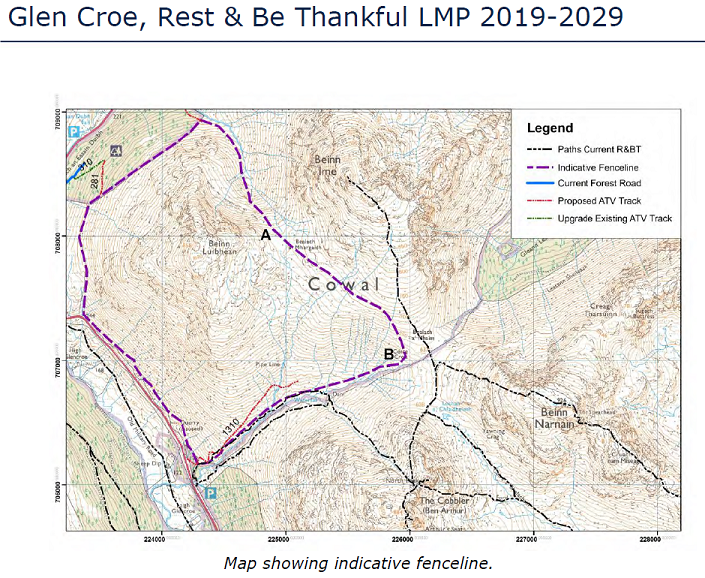
The FLS plan states that the southern flanks of Beinn Luibhean have “very low to no resident deer”, raising the question why, if the sheep and cattle are removed, over 8km of new deer fence is needed? The justification appears to be the high deer numbers in surrounding areas:
“To the north and west of the B828 and A83 lies a private forest with large numbers of deer within the trees and on the open hill. Strone Estate with interests in livestock and sporting deer stalking lies to the north and west” (extract from FLS plan).
It appears FLS fears these deer will be attracted into the area by the removal of livestock and an attractive new source of food:
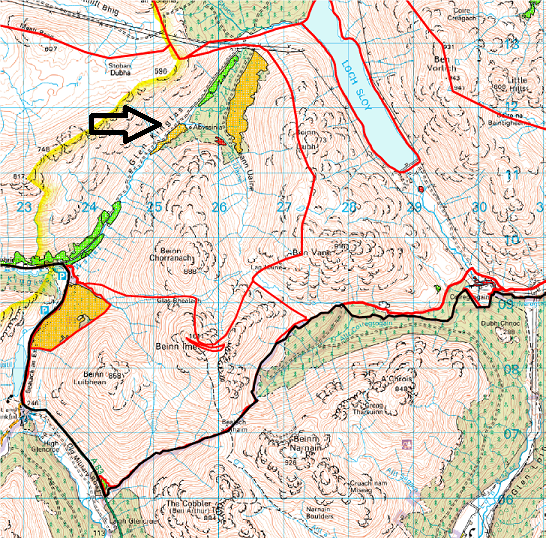
Evidence to support this is provided by the Inverary and Tyndrum Deer Management Group which covers the land north of the A83 (see here). This shows the former plantation at Butterbridge, now planted with native trees and managed by FLS, to be subject to heavy grazing pressure, as are the areas of land around Glen Kinglass:
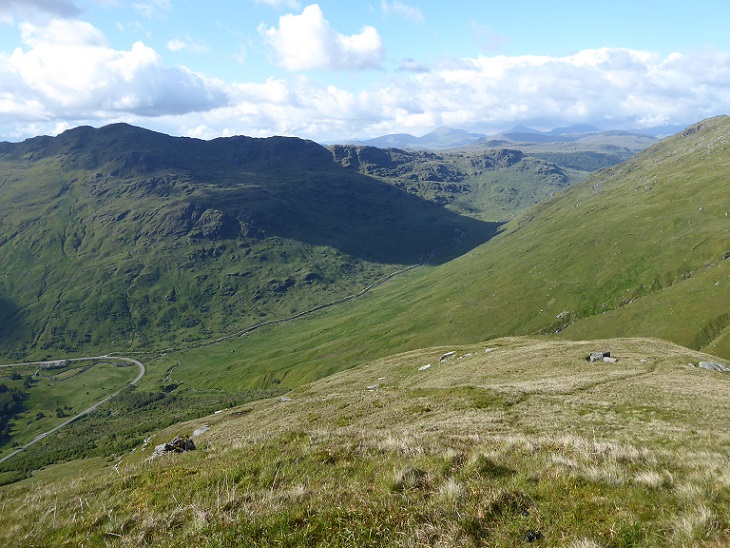
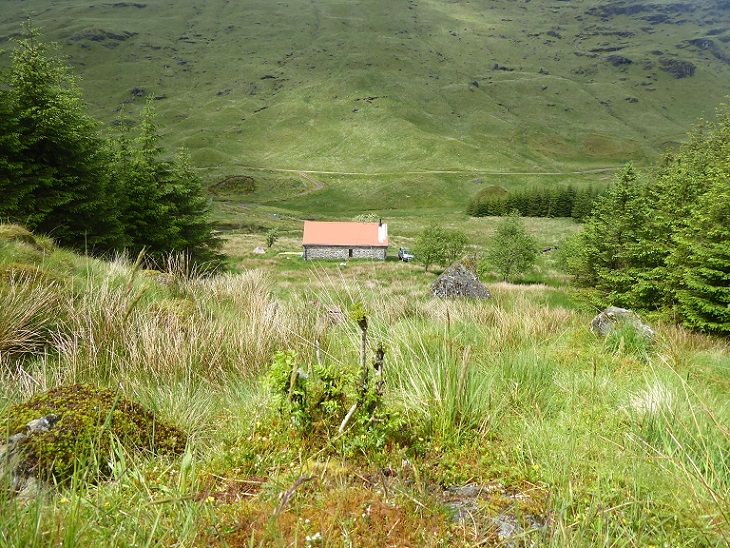
The November minutes of the Deer Management Group records that “Results of stag cull 2020 – The group is 120 stags down on the total target” and that they are still well above their target of 1400 hinds for the whole area.
There are no public minutes available for the Cowal and West Lomond Deer Management Groups which cover the land to the south but the FLS plan states “local deer densities on neighbouring FES [now FLS] land average out at roughly 10 per km square”. When you consider much of this land is covered with inedible conifer, the deer density appears very high. It is easy to see therefore why FLS are concerned that deer might be attracted from its other land to the new food source. Why not, however, take the opportunity to deal with the real issue and get their deer numbers down to the 4 per kilometre, which the documentation states is necessary to achieve natural regeneration? The 2012 Forest Research report, written before it was agreed to buy out the farmer, suggested this was quite feasible: “Grazing pressure could be reduced by deer culling and minimal stock fencing until woodland is established.”
This would have avoided the need for the deer fence which, as the documentation makes clear, will have a significant impact on access and landscape.
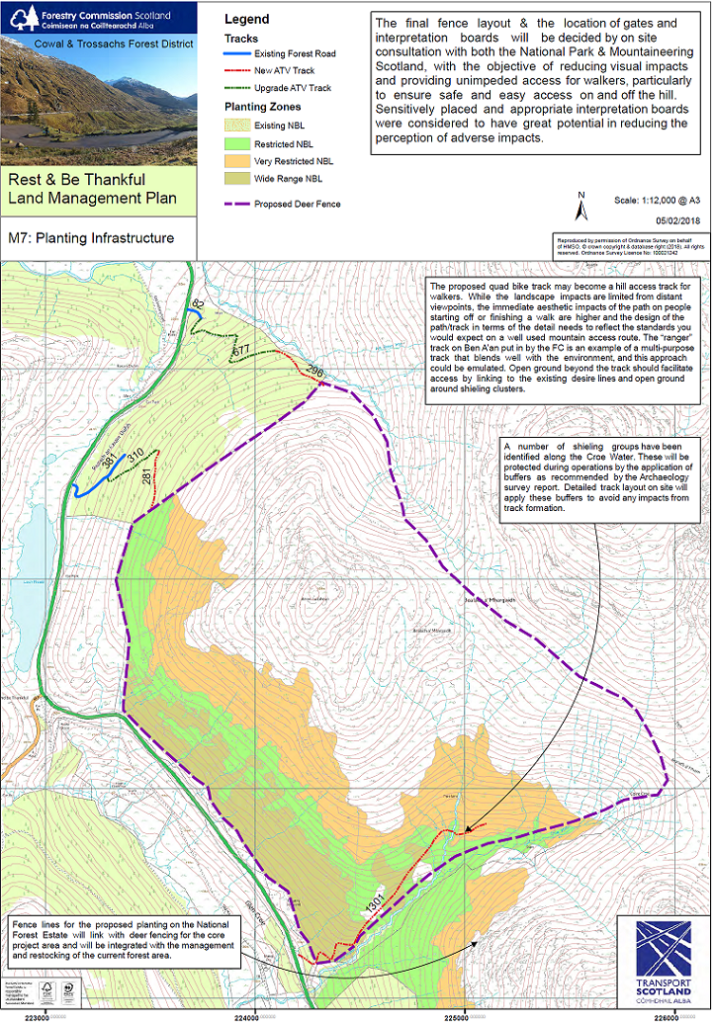
What’s more, with the FLS sensibly proposing only to plant trees where they are most urgently needed, on the slopes where landslips threaten the A83, and leaving the rest of the area to natural regeneration, only a relative small area would need to be “guarded” to allow the trees to become established. The Scottish Government current pays £9.90 a metre for “high cost” deer fencing and by my reckoning at least 8kms of fencing will be needed to circle the site, so the total cost is likely to be c£80,000. That could pay for a seasonal stalker for several years which would also enable vegetation OUTSIDE the fenced area to recover.
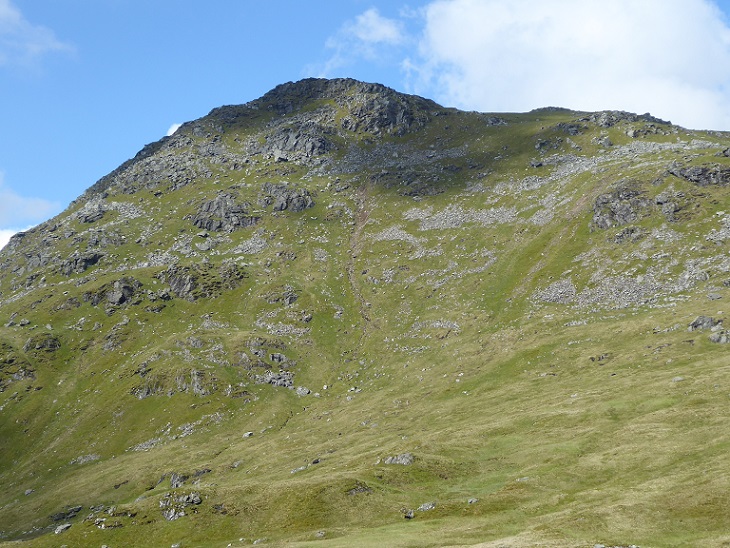
Currently, there appears to be a contradiction at the heart of the FLS plan. On the one hand they state that the fencing is needed to protect the new planting above the A83 and that this will enable vegetation on the unplanted areas higher up Beinn Luibhean to recover. But on the other hand they are claiming that by increasing their “cull on neighbouring landholdings by 50 deer per annum and culling deer within the new area as and when required” this will allow natural regeneration to take place outwith the fenced area. Both cannot be true. The answer should be obvious, FLS should follow the example of Glen Feshie and get deer numbers down to the levels where natural regeneration occurs. That would then allow the planting to take off without fencing.
Such an approach would work best if there was co-operation with neighbouring landowners but unfortunately, as again recorded in the November minutes of the Inverary and Tyndrum DMG, that does not seem to be happening: “The group wants an update about FLS woodland planting plans above the Rest – HM to ask FLS planning office”. Deer Management Groups have proved an almost totally ineffective way of reducing deer numbers.
What needs to happen
As parkswatch has pointed out previously, the large area of land stretching north from the Rest and Be Thankful all the way to Crianlarich offers huge potential for re-wilding. It’s increasingly pockmarked with fenced areas containing native woodland planting when, if deer numbers were reduced, all these patches could be linked up through natural regeneration. The overgrazing issue in the Loch Lomond and Trossachs National Park is preventing landscape scale conservation. Had the LLTNPA been prepared to take a lead on deer and publicly make the case for a reduction in grazing pressure, I believe the problems at the Rest and Be Thankful could have been addressed much earlier.
Forest and Land Scotland, as the largest landowners in the Loch Lomond and Trossachs National Park, have a key role to play in in reducing deer numbers. While culling far more deer than private landowners they are still, unfortunately, not doing enough. The are continually hampered by the LLTNPA and Nature Scot’s failures to bring down deer numbers on neighbouring private estates. As a result they end up resorting to fencing, fencing which has delayed the woodland restoration above the Rest and Be Thankful for another year.
Apart from the fencing and the deer, everything else about the Glen Croe woodland creation project appears commendable: what trees should go where is well researched; great care is to be taken with the planting methods; and the potential for natural regeneration and montane scrub going forward is well articulated. The LLTNPA and the Scottish Government should be building on this byasking FLS to apply the same methodologies to woodland restoration elsewhere, starting with at risk transport routes. But without the fencing!
Tangential to Nick’s concerns so well set out here. A potential industry to feed the nation through development of a secure UK market for venison, has almost totally floundered in Scotland. Nearly £1 million – in real money in those days – was squandered by the Quango now titled HIE (which was until 1991 a full government economic development department, known as the Highlands and Islands Development Board (HIDB))- and the then Department of Agriculture through the 1970’s on experiments in deer husbandry on marginal hill land(on Morvern). When after 7 years high expenditure the experiment had run its course, and funding dried up, the idea was deemed non-commercial. ( Partly and presumably because it undermined the lifestyle choices of a small elite group of leading people). The direct consequence of the end of funding witnessed several key project staff receiving offers for migration to New Zealand to found a Red Deer industry there. They were attracted by proper Government and regional investment and offers of citizenship. Today and over some decades in New Zealand, Red deer (sourced originally from Scotland) are raised, managed, and retained fully within fenced enclosures. The world’s appetite for venison is met by soundly resourced commercial deer raising, which results in lean meat that easily undercuts all the “wild” sourced deer meat pricing globally. Once again Scotland turned its back on commercial reality. Somehow the ravages of free-roaming wild deer, on a few vast select estates won the argument. Yet the potential of this industry within proper hill land enclosures to employ people all across Highland Scotland is staring us in the face. (And those Scots born and bred farmers relocated to NZ 40 years ago , now selling into Asian markets, laugh all the way to the bank ?)
I would argue caution when employing Forestry and Land Scotland. My local experience discovered that it is uncaring about its’ work, leaving badly damaged forest floor and pollution in its’ wake. We can only hope that their efforts on Beinn Luibhean do not follow a in a similar vein.
I know what you mean, was in the Kilpatricks yesterday west of Carbeth around Kilmannan and Burncrooks reservoir, where various work has been going on, and it was a disgrace. Broken plastic piping all over the place. My experience is that standards vary between FLS areas but the race to the bottom in terms of cutting costs and using contractors is also a significant factor in explaining poor work by FLS.
Will deer fencing not be vulnerable to land slips, and snow? If so another reason to spend £80K on stalkers. As for tunneling – I live part time in Asturias N Spain and their tunnels are terrific. Nearly all are covered with typical dense native scrub and woodland or awful eucalyptus thus somewhat ameliorating the concrete approaches.
Spot on about the vulnerable deer fencing!